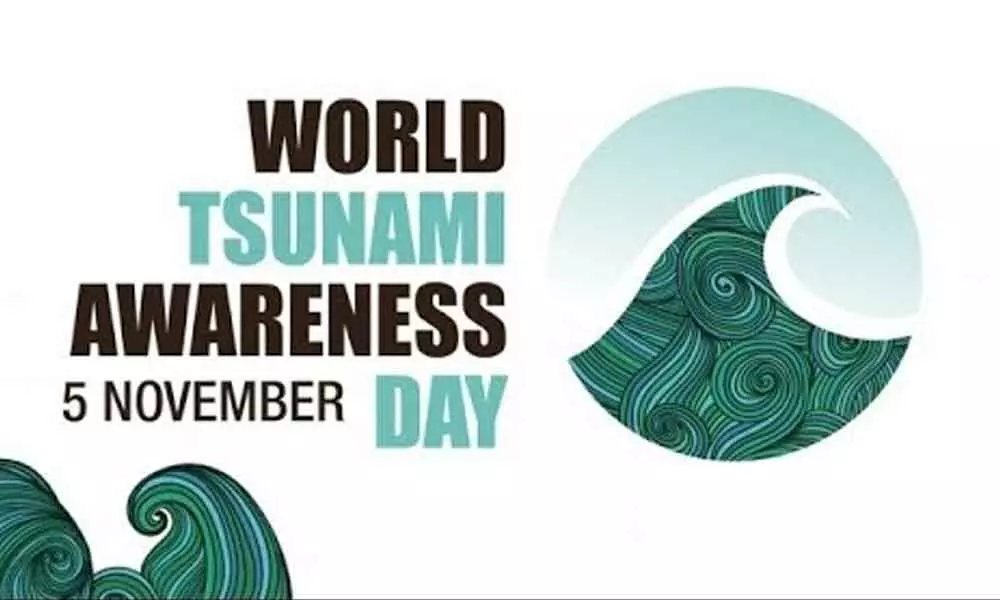Tsunami The Wave that Shook the World- World Tsunami Awareness Day 2019

World Tsunami Awareness Day 2019 will be celebrated all over the world on 5th of November, Tuesday.
World Tsunami Awareness Day 2019
World Tsunami Awareness Day 2019 will be celebrated all over the world on 5th of November, Tuesday.
History of World Tsunami Day
The word "tsunami" gets its name from the Japanese "tsu" means harbor and "nami" means wave. A tsunami is a chain of huge waves created by disturbance created underwater. These waves are normally associated with earthquakes taking place under or around the ocean.
Though tsunami is comparatively an exceptional type of natural disaster, but it causes destruction in several nations around the world. Tsunamis pose a severe threat to the world and it could even obstruct the accomplishment of sustainable growth. The Sendai Framework for the Reduction of Disaster Risk was adopted at the 3rd WCDRR (World Conference on Disaster Risk Reduction) held at the United Nations in March 2015.
At the conference held in Sendai, the Agenda for 2030 for Sustainable Development was also proposed. This influenced Japan along with many other countries to dedicate a specific day as the "World Tsunami Awareness Day" and the same was designated by the UN.
Fifth November was chosen as the World Tsunami Awareness Day in the honor of the famous Japanese tale of "Inamura-no-hi", which means "burning of the rice sheaves". During an earthquake in the year 1854, a farmer noticed the tide diminishing which is a sign of an approaching tsunami. In order to warn the villagers, he set his entire harvest on fire; the villagers, as a result, evacuated the village immediately and fled to higher ground. Later, he constructed an embankment to plant trees as a barrier against future tides.
Though they may be rare, tsunamis are among the most devastating natural disasters. They know no coastal borders. Coastal communities – often concentrated in low-lying and highly populated areas – are the most potentially vulnerable to coastal hazards including tsunamis, with heavy human and economic losses. International cooperation is key for deeper political and public understanding; as well as involvement in reducing our risks from these coastal natural hazards.
In December 2015, the United Nations General Assembly designated 5 November as World Tsunami Awareness Day to promote a global culture of tsunami awareness.
What is a Tsunami?
Did you know that tsunamis are considered rare but are extremely deadly?
A tsunami is a series of ocean waves that sends surges of water, sometimes reaching heights of over 100 feet (30.5 meters), onto land. It can kill or injure people, damage and destroy infrastructure facilities and can cause flooding and disrupt transportation, communication lines, power and water supply. In other words, tsunamis can wipe out areas with these walls of water in a short time can lead to a widespread of destruction in an area.
Tsunamis are typically caused by large, undersea earthquakes at tectonic plate boundaries. Other causes of tsunami include underwater landslides and volcanic eruptions. When the ocean floor at a plate boundary rises or falls suddenly, it displaces the water above it and launches the rolling waves that become a tsunami.
Causes of Tsunamis
Tsunami waves are highly dangerous and generally look like strong walls of water. The strong waves can attack the seashore for hours, thereby destructing thousands of lives. There are several causes of Tsunami such as submarine landslides, Earthquake, Coastal rock falls, volcanic eruptions or Extraterrestrial Collision.
Actions should be taken
It is important to recognize the natural warning signs of Tsunami in order to take preventive measures. Since huge earthquakes may cause tsunamis, you must be able to feel the earth shaking severely, or constantly. Tsunami may also cause due to a swift fall in the level of the sea when the ocean recedes. If you see an abnormal disappearance of water or if you notice a wall of water approaching, realize it is tsunami.
Tsunami creates a thunderous "roaring" sound similar to that of an aircraft or train. If you sense any of these symptoms, don't delay for formal evacuation orders; instead leave the low-lying coastal areas instantly. You must immediately run when the tsunami approaches.
What is World Tsunami Awareness Day
The World Tsunami Awareness Day is an initiative of the UN General Assembly to harness international cooperation in understanding risk reduction measures. The observance of the World Tsunami Awareness Day is set on every 5th of November. The date was chosen in honor of a true story from Japan: "Inamura-no-hi", which means the "burning of the rice sheaves".
During the 1854 earthquake in Japan, a farmer saw the tide receding, a sign of a looming tsunami. He set fire to his harvested rice to warn villagers, who fled to high ground. In the aftermath, he helped his community build back better to withstand future shocks, constructing an embankment and planting trees as a tsunami buffer.
The 5th of November manifests that even in the past, people and communities were aware of the hazards and risks. And it is with community effort and participation that disaster resilience can be achieved.
The true story of Inamura-no-hi is a reminder of the power of community participation and cooperation.
The observance of the World Tsunami Day aims to increase tsunami awareness, to strengthen community participation and cooperation and to share innovative practices and approaches to risk reduction. This year's theme aligns with the International Day of Disaster Reduction which aims at reducing direct disaster economic loss in GDP.
The Philippines through the National Disaster Risk Reduction and Management Council will join the observance of the World Tsunami Day on November 5, 2018 and is set to conduct a tsunami drill in Pagadian City, Zamboanga.
Why is World Tsunami Awareness Day Celebrated?
World Tsunami Awareness Day is celebrated to create awareness amongst people about the risks associated with the tsunami and the preventive measures to be taken when a tsunami approaches. Since the natural disasters don't recognize borders, so the United Nations suggested 5th November as the World Tsunami Awareness Day and appealed for global cooperation in increasing prevention efforts and public awareness.
Though tsunamis are rare, its devastating impact can cost many lives. The destructive tsunamis of the years 2004 and 2011 have proved to the world how fatal these natural calamities can be. This has also brought to the notice that most of the people are unaware of the early signals of the tsunami and the preventive actions to be taken when the tsunami occurs or waves strike.
World Tsunami Awareness Day helps in improving our knowledge and awareness of tsunamis, and how should we react if stuck in any such situation. Several conferences, debates, seminars, quiz etc are organized at national and international levels to make people aware of the tsunami risk.
The national government should take every step to guide the people timely and appropriately in the event of tsunamis. Early warning signals can save several lives. They should be evacuated to safe places and should be supplied with necessary items such as food, water, clothes, etc.
Even though huge buildings and mechanical and scientific innovations can delay tsunamis but such innovations do not protect people completely from tsunamis. During the 2011 tsunami, many evacuation centers were constructed 20 meters above the sea level, at Japanese city Minamisanriku, Japan to prevent disasters. These centers were poorly swamped and huge population was washed away. Thus, the international bodies have to be more cautious and find out better preventive ways.
Conclusion
The Indian Ocean tsunami occurred in 2004 caused the United Nation to implement the tsunami warning signals and systems globally. The real-time data from the bottom of the ocean pressure sensors and GPS installed at the offshore are assisting tsunami warning centers to cancel or issue alerts and warnings more rapidly and accurately. For a remote tsunami, real-time monitoring of the sea level and earthquake for confirming the occurrence of a destructive tsunami is critical. The immediate warning must be issued to the public in such cases. A local tsunami doesn't allow sufficient time for the warning signals to be issued. In such situations, people must act wisely and respond immediately.
Though Tsunamis are unusual events, these can be awfully deadly. In the last 100 years, around 58 tsunamis have destructed approximately 260,000 lives which is an average of 4,600/disaster. This has surpassed all other natural calamities. The maximum number of deaths had occurred in December 2004 in the Indian Ocean tsunami. It caused approximately 227,000 deaths in 14 countries including India, Indonesia, Sri Lanka and Thailand being the hardest-hit.














